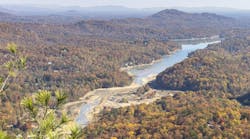A Watershed Response
Related search terms from www.waterinfolink.com: economic stimulus, ARRA, U.S. EPA
Recently signed into law, the American Recovery and Reinvestment Act (ARRA) has earmarked billions of dollars for infrastructure improvements. The U.S. Environmental Protection Agency (EPA) will play a key role in managing, tracking and reporting on the progress of the ARRA’s storm water-related allocations, and Jim Hanlon of EPA’s Office of Water shared need-to-know details with Storm Water Solutions Managing Editor Caitlin Cunningham.
Caitlin Cunningham: The newly signed $787-billion ARRA includes about $12 billion for water projects. Do you anticipate the storm water sector will benefit from this investment? If so, how?
Jim Hanlon: Yes. The ARRA includes $7.22 billion for projects and programs administered by EPA. The Clean Water State Revolving Fund (CWSRF) program will receive $4 billion. The Drinking Water State Revolving Fund (DWSRF) program will receive $2 billion.
In addition to traditional wastewater treatment projects, the CWSRF helps fund nonpoint source pollution control, including storm water runoff and watershed and estuary management. Communities with Phase I or Phase II NPDES permits may fund combined sewer overflow and sanitary sewer overflow correction projects; sewer system rehabilitation; new collector sewers; new interceptors; storm sewer rehabilitation; infiltration/inflow correction; and storm water management facilities so long as these projects address problems in a publicly owned system.
Cunningham: What do industry professionals need to know about this bill?
Hanlon: The purpose of the funding is to get people back to work, so preference will be given to projects that can be started and completed expeditiously—with a goal of using at least 50 percent of funds on projects that can begin within 120 days after enactment. All funds must be under contract or construction within 12 months of enactment.
One of the most exciting aspects of the ARRA is the requirement that states focus 20 percent of their SRF dollars to promote “green” infrastructure, water and energy efficiency and environmentally innovative projects such as those that support low-impact or smart-growth development. Before a state can redirect green infrastructure funds to traditional projects, a state must certify to EPA that they lack sufficient eligible applications.
Another opportunity to promote the use of alternative approaches is the increase of Section 604(b) planning funds. The stimulus package provides a set-aside of $39 million for states and regional planning agencies to use for a broad range of water quality management planning activities.
Cunningham: When and how should groups with shovel-ready projects apply for funding?
Hanlon: To receive Recovery Act funding, a state will have to incorporate details of the new funding in their 2009 Intended Use Plan (IUP) or provide a supplemental IUP that describes how the funds will be used. As with their normal IUP, states will have to make the document available to the public for review and comment. Communities that are interested in receiving assistance for a project must contact their state SRF programs to be placed on the state’s priority list for funding.
Under the SRFs, the only scenario where a state would provide funding to an individual or private organization rather than a public water system or a wastewater treatment system is if they were providing CWSRF assistance under nonpoint source program eligibility.
Download: Here

